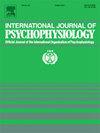The relevance of accounting for parasympathetic as well as sympathetic arousal in threat conditioning: Methodological and clinical considerations
IF 2.5
3区 心理学
Q3 NEUROSCIENCES
引用次数: 0
Abstract
Alterations in associative threat learning have been thought to underlie the aetiology and maintenance of anxiety disorders. Recent insights into the facilitatory role of parasympathetic arousal for threat coping have raised the question whether individual differences in sympathetic versus parasympathetic dominance during threat learning may shed light on the complex relationship with anxiety vulnerability versus resilience. We applied an established differential-cue delay threat conditioning paradigm in 78 neurotypical individuals and assessed parasympathetic responses (threat-induced bradycardia), as well as sympathetic responses (threat-induced tachycardia and increased skin conductance responses-SCR). We found evidence that patterns of threat-induced bradycardia as well as tachycardia are present during associative learning. Threat bradycardia was linked to weaker initial conditioned SCRs (mainly driven by responses to the CS+), a finding that may be relevant for current common practice in the field of threat learning: namely participants with weak differential skin conductance responses - who according to frequently applied ‘SCR non-learner’ criteria are often considered non-learners and sometimes even excluded from analyses - were in fact showing successful learning in terms of parasympathetic arousal. Additionally, the presence of threat bradycardia as well as the magnitude of overall conditioned heart rate responses were linked to relatively lower trait anxiety. These findings not only have practical research implications but also clinical implications when assessing markers for anxiety vulnerability versus resilience.
求助全文
约1分钟内获得全文
求助全文
来源期刊
CiteScore
5.40
自引率
10.00%
发文量
177
审稿时长
3-8 weeks
期刊介绍:
The International Journal of Psychophysiology is the official journal of the International Organization of Psychophysiology, and provides a respected forum for the publication of high quality original contributions on all aspects of psychophysiology. The journal is interdisciplinary and aims to integrate the neurosciences and behavioral sciences. Empirical, theoretical, and review articles are encouraged in the following areas:
• Cerebral psychophysiology: including functional brain mapping and neuroimaging with Event-Related Potentials (ERPs), Positron Emission Tomography (PET), Functional Magnetic Resonance Imaging (fMRI) and Electroencephalographic studies.
• Autonomic functions: including bilateral electrodermal activity, pupillometry and blood volume changes.
• Cardiovascular Psychophysiology:including studies of blood pressure, cardiac functioning and respiration.
• Somatic psychophysiology: including muscle activity, eye movements and eye blinks.

 求助内容:
求助内容: 应助结果提醒方式:
应助结果提醒方式:


